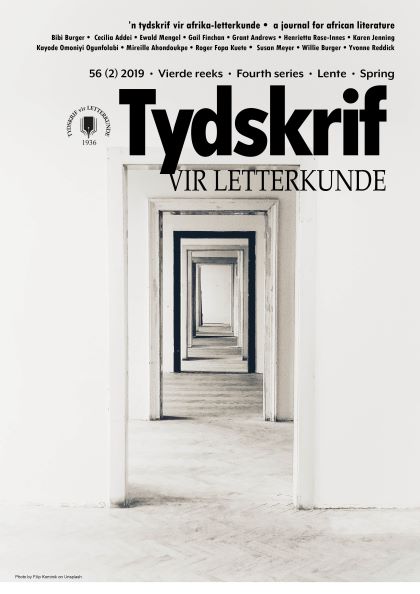Biracialism and trauma in Kaine Agary's Yellow-Yellow
DOI:
https://doi.org/10.17159/2309-9070/tvl.v.56i2.4664Keywords:
biracialism, trauma, testimony, visibility, invisibilityAbstract
The connection between the discourse of racial purity and its traumatic effects on the biracial woman takes center stage in Kaine Agary’s Yellow-Yellow, which manifests in valorization and vilification of biracial subjects. Contrary to received and discriminatory knowledge that equated biraciality with degeneracy and hyper-sexuality, this article argues that master narratives of social marginality, and stigmatization of biracial women are undermined through the counter-narrative of subjects that deconstructs the dialectic of visibility and invisibility of the biracial body. Appropriating the stereotypes against them, victims recover their subjectivity by articulating their stories, which transgress an ossified binary perception of race. Though these stories do not provide narrative closure, they embrace the contradictions and ambivalence that characterize existential realities of biracial bodies, and therefore, rupture the singular and normative narrative that names biracial women as ‘other’.
Downloads
References
Agary, Kaine. Yellow-Yellow. Dtalkshop, 2006.
Azumurana, Solomon O. “Freud’s ‘Penis Envy,’ Lacan’s the ‘Desire to be the Other’ Nigerian Feminist Aesthetics: Adimora-Ezeigbo’s Children of the Eagle and Kaine Agary’s Yellow-Yellow.” Journal of the African Literature Association vol. 6, no. 1, 2016, pp. 151–63. DOI: https://doi.org/10.1080/21674736.2011.11690177.
Burgin, Victor. In/Different Spaces: Places and Memory in Visual Culture. U of California P, 1996.
Caruth, Cathy. Unclaimed Experience: Trauma, Narrative, and History. Johns Hopkins U P, 1996.
Chukwumah, Ignatius. “The Displaced Male-Image in Kaine Agary’s Yellow-Yellow.” Tydskrif vir Letterkunde vol. 50, no. 2, 2013. pp. 47–62. DOI: http://dx.doi.org/10.4314/tvl.v50i2.4.
Feghabo, Charles Cliff. “Inverting Otherness in Kaine Agary’s Yellow-Yellow.” Matatu vol. 45, no, 1, 2014, pp. 315–32. DOI: https://doi.org/10.1163/9789401211093_019.
Felman, Shoshana & Dori Laub. Testimony: Crisis of Witnessing in Literature, Psychoanalysis, and History. Routledge, 1992.
Foucault, Michel. The History of Sexuality: An Introduction. Trans. Robert Hurley. Vintage, 1978.
Herman, Judith L. “Crime and Memory.” Trauma and Self. Eds. Charles B. Stozier & Michael Flynn. Rowman & Littlefield, 1995, pp. 3–17.
Janis, Michael. “Yellow-Yellow.” Africa: Journal of the International African Institute vol. 78, no. 2, 2008, pp. 325–26. https://jstor.org/stable/29734341.
Krystal, John H. et al. “Post Traumatic Stress Disorder: Psychological Mechanisms of Traumatic Remembrance.” Memory Distortion: How Minds, Brains, and Societies Reconstruct the Past. Eds. Daniel E. Schacter. Harvard U P, 1995, pp. 150–72.
Loftus, Elizabeth F. et al. “The Reality of Illusory Memories.” Memory Distortion: How Minds, Brains, and Societies Reconstruct the Past. Ed. Daniel E. Schacter. Harvard U P, 1995, pp. 47–68.
Norridge, Zoe. Perceiving Pain in African Literature. Palgrave Macmillan, 2013.
Simon, E. D. “The Niger Delta Region and the Woman’s Predicament: A Study of Kaine Agary’s Yellow-Yellow.” African Research Review vol. 4, no. 3b, 2010, pp. 155–66.
Stoler, Laura Ann. Carnal Knowledge and Imperial Power: Race and the Intimate in
Colonial Rule. U of California P, 2010.
Downloads
Published
Issue
Section
License
Copyright (c) 2019 Tydskrif vir Letterkunde

This work is licensed under a Creative Commons Attribution-ShareAlike 4.0 International License.


 https://orcid.org/0000-0001-6465-6584
https://orcid.org/0000-0001-6465-6584


.png)